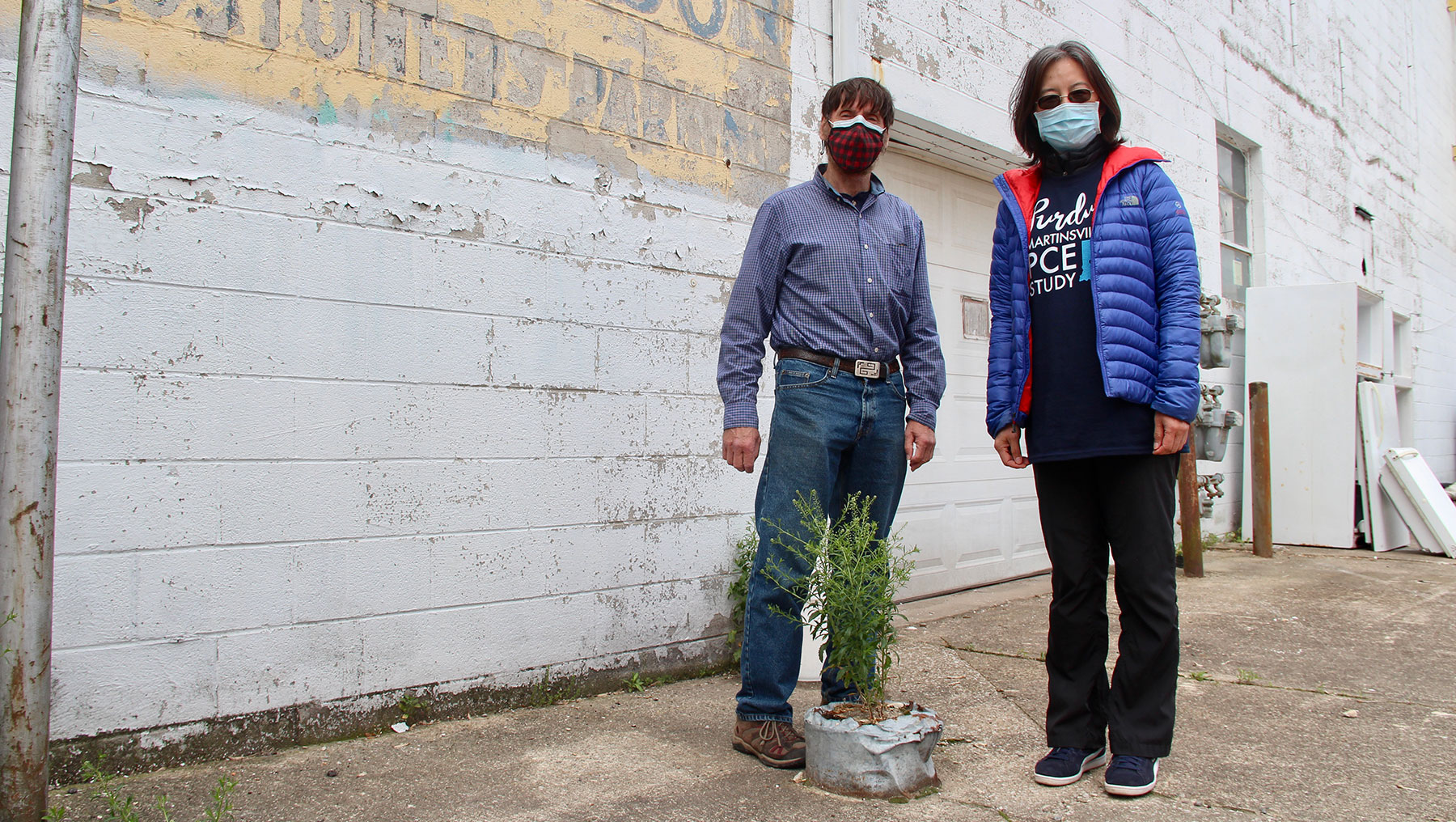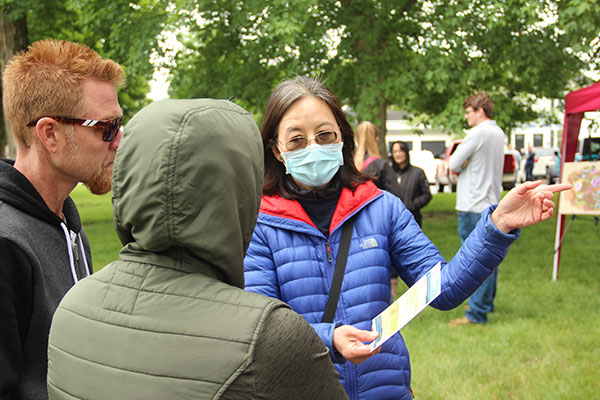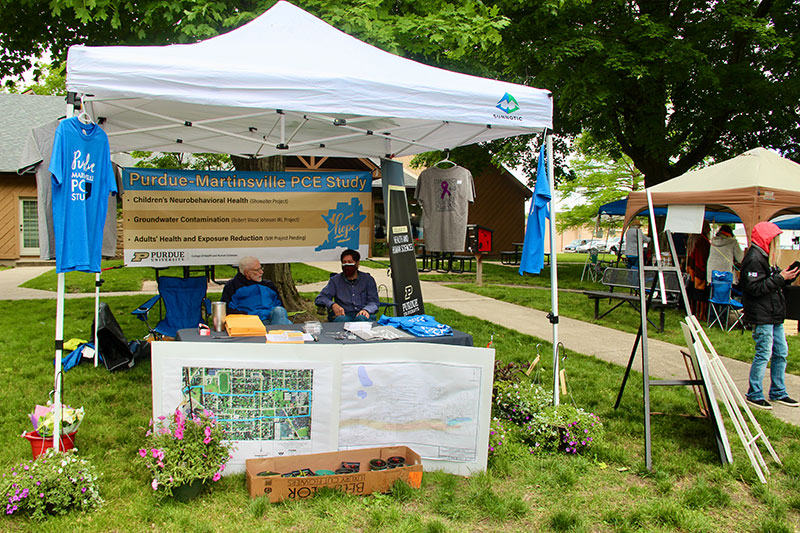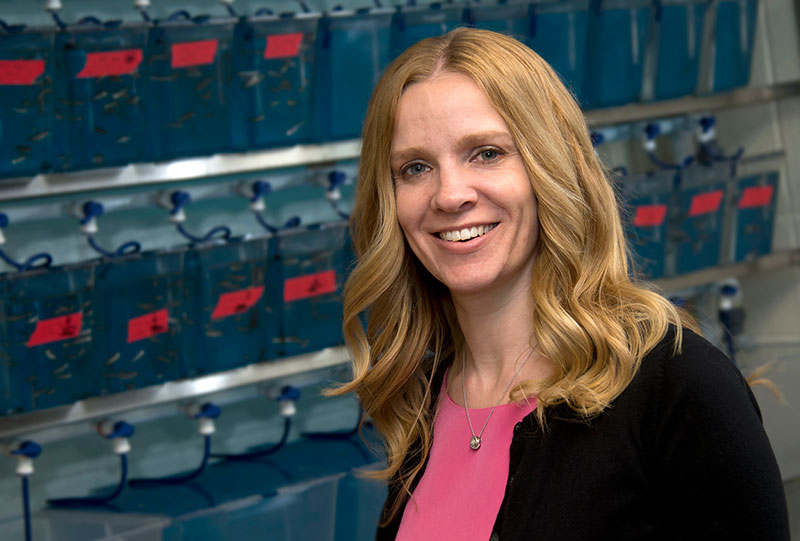Purdue researchers uncover contaminants in water, soil and indoor air in Indiana communities

Sa Liu, right and assistant professor in the School of Health Sciences, stands at “ground zero” of the Martinsville Superfund site, which saw a dry-cleaning company illegally dump gallons of PCE into a well in 1991, with Tom Wallace, founder of a Martinsville PCE task force. The groundwater as well as the air inside homes and businesses near the site still contain amounts of the dangerous chemicals 30 years later.
By Tim Brouk, tbrouk@purdue.edu
Researchers in the Purdue University College of Health and Human Sciences (HHS) are examining human health responses to dangerous chemical and metal exposures in Indiana. Much of their work has already garnered headlines and publications, but more importantly, it has brought attention to at-risk Indiana communities, which could eventually lead to policy changes and a healthier Hoosier state.

Sa Liu talks to Martinsville community members on May 29 about the dangerous chemical PCE that is still found in the city’s groundwater.
Martinsville
Since 2019, Sa Liu, assistant professor of health sciences, has focused her research on the prevalence of tetrachloroethylene, also known as PCE, in the groundwater, drinking water and indoor air in the small city of Martinsville. The dangerous neurotoxicant often used in dry cleaning and laundry services was found in 100% of tap water samples, 60% of indoor air samples and 100% of exhaled breath samples, according to Liu’s original findings.
The Environmental Protection Agency (EPA) deemed an area of the city a Superfund site 19 years ago, tracing PCE’s presence to a former Martinsville dry cleaning and laundry business that illegally dumped the chemical. An EPA Superfund site is a highly contaminated area that requires investigation and clean-up of hazardous substances.
Liu is interested in how the presence of PCE in the community’s water and air has affected human health over the decades. Prolonged exposure could have affected adult populations in terms of memory, reaction time and mood and could have had adverse effects on neurological and behavioral development in children. It also could be a link to heightened cancer rates in the area.
Recent reports have said the levels of PCE have been on the rise because the chemical has had 30 years to spread around the area, affecting city and well water. In 2005, an activated carbon filtration system was installed to remove the PCE from the city water to make it safer to drink. However, it can still be found in the groundwater.

Sa Liu and her collaborators man a booth at the Morgan County Farmers Market to raise awareness of the Purdue-Martinsville PCE Study.
“PCE was originally poured on the ground, and the compound reached the soil, then went deeper into the groundwater,” said Liu, who is collaborating with Purdue assistant professor of anthropology Jennifer Lee Johnson, Martinsville community partner Deborah Corcoran and Center for the Environment. “It has had years to move around, so the original contamination spot may not have the highest concentration.”
Liu is currently studying how much PCE can be found in the residents themselves. With funding from Robert Wood Johnson Foundation’s Interdisciplinary Research Leaders program and the Ralph W. and Grace M. Showalter Research Trust, she will be knocking on doors this summer in search of young study participants to learn how much PCE has affected the learning and behavioral levels in Martinsville children. Her goal is to test 80 Martinsville children for the dataset — 40 from the contaminated areas and 40 children outside of the areas for comparison.
The children will complete iPad-based surveys to determine cognitive and behavioral performances. Working with community members, Liu and her research team will also collect indoor air and breath samples to see how much PCE and other chemicals are in their young systems. She will also bring a mobile mass spectrometry lab to Martinsville, which will provide real-time sample analysis.
“We want the results to be used by the community to make changes,” Liu said. “We’ve put in lots of work to disseminate information and get community members engaged, involved and acknowledged for their engagement. This is important for us to do the science and make the science impactful.”
East Chicago
One of the most contaminated areas in the United States is about 90 minutes northwest of Purdue’s West Lafayette campus. The USS superfund site in East Chicago includes the USS Lead facility along with nearby commercial spaces and neighborhoods.
For years, lead and arsenic — both highly toxic to humans — seeped into the soil and groundwater of the small city in Lake County, which experts believe has resulted in elevated exposure among the people living and working there, most of whom were low-income residents. The hazardous environment displaced residents from the Calumet Housing Complex, which had to be demolished, and it affected families trying to find a new school for their children after the closure of Carrie Gosch Elementary School. Both buildings were in the most contaminated area of the Superfund site.
The dangers of the contaminated area have been known for decades. Many studies have revealed the children living in the contaminated area were nearly three times more likely to suffer from lead poisoning.



“That was the big tragedy,” said Ellen Wells, associate professor of health sciences. “We’ve done a lot of research on it, but it’s still in our environment. We need to keep a spotlight on these issues, so we can follow through the whole way — getting the public support and interest to put the money behind what it would take for the clean-up.”
Lead is most hazardous to the neurological development of young children. Around the age of 2, children are in rapid brain development. Lead exposure at this stage disrupts neuronal connections in the brain, affecting cognition, emotional control and behavior. This results in lifelong problems for the exposed individual.
During one of her many visits to the area, Wells and her team invited the community to bring soil samples from their yards. Wells set up X-ray fluorescence devices, which quickly detect metallic levels in soil by bombarding the samples with X-rays and then reading metals’ electrons that react to the rays.
The samples ranged in levels of toxicity, further adding data to the research and awareness in the community. The results of the scans were shared with the community to educate and warn what is underneath their feet in their city. This work was funded by the Ralph W. and Grace M. Showalter Research Trust.
“We found that a significant proportion of samples brought in were contaminated with lead over the limit the EPA recommends, and a significant proportion of samples were contaminated with arsenic over what the EPA recommends,” recalled Wells, who recently published this work in Chemosphere.
While Wells’ research extends to other regions of Indiana, her work in East Chicago has raised awareness of the continued dangers of the area’s contamination, especially lead. The work in the city of about 30,000 people is a prime example of why she has dedicated her research to the dangers of environmental contamination.
“People didn’t have a choice whether to be exposed to these things or not,” Wells explained. “There’s a vast amount of research that it really does affect health. At the same time — because it’s environmental rather than behavioral from a public health standpoint — we actually have a better chance at doing something about it. We can implement citywide or companywide regulations to help prevent environmental contaminants.”
Rural Indiana

Jennifer Freeman, associate professor of health sciences
Several Purdue Health and Human Sciences faculty members have studied the use of chemicals on Indiana farms. These widespread rural areas rely on producing ultimate crop yields, sometimes to the detriment of the environment and nearby human populations.
According to Jennifer Freeman, associate professor of health sciences, the herbicide chemical atrazine is often used in Indiana to help crop growth. The weed killer has been used for years, so much that atrazine has been found in drinking water supplies all around the state.
Any atrazine found in drinking water in areas like West Lafayette is expected to be low, as it is regulated by the EPA and monitored, but in rural populations that rely on private well water, the chemical’s presence in the water can be higher and is generally not monitored.
“Monitoring of private well water is the responsibility of the homeowner,” Freeman said. “A few weeks after atrazine is first applied to agriculture fields and once we have that first heavy rain event, that’s when you’re going to have a spike in the chemical in drinking water sources.”
Freeman has studied atrazine’s effects on the human body since graduate school. She has found the chemical affects the human neuroendocrine system by suppressing the release of certain hormones within the reproductive system, which could lead to reproduction issues to those exposed to too much atrazine. The most common way we are exposed to atrazine is through drinking water.
Much of Freeman’s research has utilized zebrafish models. The small, striped fish commonly found in aquariums and pet stores offer a versatile animal model system used to further life-saving human research. The fish’s genomes were sequenced, studied and published decades ago, giving researchers like Freeman a quick database for genetic research. Zebrafish’s metabolism of chemicals is similar to humans’, and 80% of the fish’s genes are identical to humans’.
Funded by National Institutes of Health and Purdue AgSEED grants, Freeman’s ongoing atrazine research was inspired by her young, growing family while living in rural Clinton County, Indiana. And yes, her family relies on well water at home.
“Our intention is to try to understand those exposures that we have in today’s society and understand if there is a health risk associated with it,” Freeman said. “We hope to be able to inform policy and regulations when we’re working with these chemicals overall to make smart decisions and protect human health.”